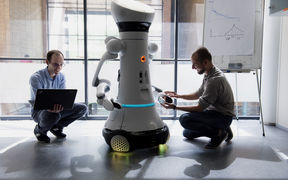Smart buildings make life easier and use less energy

When he leaves work, Aalto University Professor of Practice Jaakko Ketomäki uses his mobile phone to switch on his coffee machine’s smart socket, which is connected to the security system in his home. On arrival, freshly brewed coffee awaits him in a house that’s been cleaned by a robot and where the heating system lowered the temperature by a couple of degrees while he was at work. The automated system even keeps a constant eye on the price of electricity and heats the water at night, when the rates are lowest.
‘Smart building technology adds to the comfort and ease of living. It makes energy consumption transparent and helps save energy in just the right places, whether at home or in a large office building,’ says Ketomäki.
The idea of a smart building does not require that users know or even care what kind of technology is integrated into the building.
‘Users don’t need to go under the hood of a smart building. All they need is an easy-to-use app to control the functions they want. A smart building uses data monitoring and user feedback to constantly learn how to control things more intelligently,’ says Professor of Practice Heikki Ihasalo from the School of Electrical Engineering.
Robot helpers
The most visible element of building services engineering is lighting, yet automation and wireless technology will eventually make light switches a rarity. A smart office learns how people move in the building and adjusts the lighting accordingly. Today, it’s easy to equip lights with sensors that collect automation data, such as occupancy rates and indoor air quality.
‘A smart building keeps the indoor air clean and at just the right temperature. For users, the system saves energy because the lights are never on unnecessarily, and the heating adjusts in response to fluctuations in the price of electricity, which are increasing as renewable energy production grows,’ says Ihasalo.
Smart solutions are also needed to control a building’s power load and balance consumption peaks – for example, by ensuring that electric cars aren’t all charging at the same time.
Another element of smart buildings is helping people find their way. At the Otaniemi campus, the Aalto Space mobile app guides freshmen to the right auditorium and to available study spaces.
‘An access control app in your pocket is invaluable when you need to find a free desk or locate colleagues in a large office building. Workspace reservations are an essential part of this kind of service,’ saysKetomäki .
On the other hand, advanced robotics plays a visible part in the daily life of people on campus, with delivery robots taking shopping bags from store to door and robotic vacuum cleaners helping clean the premises. Robots are being used to transport goods in hospitals, to take care of room service in hotels and to deliver mail in offices. Robots can even communicate with lifts to move between floors.
Smarter energy use
The Aalto doctoral school about smart buildings trains experts to have a comprehensive view of building technology, IT systems and, above all, the needs of users. To support the programme – the first of its kind in Finland – the school received a donation of 1.5 million euros last spring.
Smart building technology is becoming increasingly important because we need to become ever smarter in our energy use. Digitalisation and automation are also bringing increased versatility to the control of building services.
Various methods have been developed in recent years to assess how smart a building is. One of them is the Smart Readiness Indicator (SRI), which was developed at the EU level and is now being tested for usability in Finland.
‘The indicator divides building services into domains such as heating, domestic hot water and ventilation, and examines their smartness one by one. SRI is part of the Energy Performance of Buildings Directive (EPBD), in which the flexibility of power consumption and energy storage play an important part. At Aalto, we are studying the implementation and benefits of SRI in Finland,’ says Ketomäki.
Other research topics at the doctoral school include lighting control, user-centricity and analytics of building automation data. The school’s goal is to power up networks between graduate students and businesses.
‘A new form of corporate collaboration consists of part-time doctoral students whose research uses data collected by businesses. This also ensures that the very latest research knowledge is passed on from the university to the business world,’ Ihasalo says.
Because of its cold climate, Finland has always had strong expertise in building services engineering. The country is also at the leading edge of smart building development. Last year, the Workery+ coworking space in Helsinki, developed by the YIT Group, was selected as the world’s smartest building.
The founding of the doctoral programme was supported by donations from
- Center for Electrical Engineering and Energy Efficiency STEK
-
Electrical Contractors’ Association of Finland STUL
-
Finnish Electrotechnical Trade Association STK
-
K.V. Lindholm Foundation
-
Kiinteistösäätiö
-
Finnish Association of Civil Engineers RIL
- Granlund
- Helvar
- Ramboll
- Caverion
Text: Marjukka Puolakka
Illustration: Juuli Miettilä
This article has been published in the Aalto University Magazine issue 31 (issuu.com), October 2022.
Saving energy with smart building services engineering
The donation for the teaching and research in smart building services engineering and smart buildings has accelerated the development of the field and inspired new students.

Read more news

Aalto Inventors innovation training coming for hydrogen, quantum and microelectronics researchers this spring
Connect with industry and academic thought-leaders and gain widely applicable skills in communication, intellectual property, and business.Growing Materials, Growing Ideas: Inside the BioMaker Studio
At Aalto University’s BioMaker Studio, initiated by Ena Naito, students and researchers experiment with living materials, from algae to mycelium, creating an open, interdisciplinary space where design, biology, and collaboration grow together.
Aalto in 2025: Quantum leaps, creative breakthroughs and solutions for a better life
Growth, technology and industrial renewal; human-centred solutions; health and everyday wellbeing; and enjoyable daily life and thriving communities.






